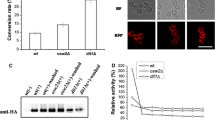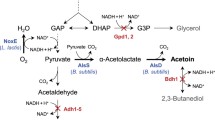Abstract
Objectives
To achieve consecutive conversion from creatinine to urea and sarcosine using creatininase and creatinase encapsulated in spores of Saccharomyces cerevisiae.
Results
Creatininase encapsulated into the spore wall was produced and its specific activity was 3.4 ± 0.4 U/mg. By deletion of OSW2 gene, which causes a mild spore wall defect, the activity was increased to 10.9 ± 0.5 U/mg. Compared with soluble enzymes, spore-encapsulated creatininase was tolerant to environmental stresses; creatininase encapsulated in osw2∆ spores retained more than 90 % of the activity after treatment by SDS or proteinase K. Creatinase capsules could also be produced through spore encapsulation. The mixture of spores containing either creatininase or creatinase could mediate a two-step reaction to produce urea from creatinine; 5 mg spores produced 19 µmol urea in 10 min. Spores co-expressing creatininase and creatinase could also mediate the reactions more efficiently than the mixture of spores individually expressing each enzyme; the yield in 10 min was 38 µmol.
Conclusions
Yeast spores can hold creatininase and creatinase simultaneously and catalyze the consecutive reactions.






Similar content being viewed by others
References
Briza P, Breitenbach M, Ellinger A, Segall J (1990) Isolation of two developmentally regulated genes involved in spore wall maturation in Saccharomyces cerevisiae. Genes Dev 4:1775–1789
Coluccio A, Bogengruber E, Conrad MN, Dresser ME, Briza P, Neiman AM (2004) Morphogenetic pathway of spore wall assembly in Saccharomyces cerevisiae. Eukaryot Cell 3:1464–1475
Longtine MS et al (1998) Additional modules for versatile and economical PCR-based gene deletion and modification in Saccharomyces cerevisiae. Yeast 14:953–961
Mumberg D, Muller R, Funk M (1995) Yeast vectors for the controlled expression of heterologous proteins in different genetic backgrounds. Gene 156:119–122
Neiman AM (2005) Ascospore formation in the yeast Saccharomyces cerevisiae. Microbiol Mol Biol Rev 69:565–584
Neiman AM, Katz L, Brennwald PJ (2000) Identification of domains required for developmentally regulated SNARE function in Saccharomyces cerevisiae. Genetics 155:1643–1655
Pammer M, Briza P, Ellinger A, Schuster T, Stucka R, Feldmann H, Breitenbach M (1992) DIT101 (CSD2, CAL1), a cell cycle-regulated yeast gene required for synthesis of chitin in cell walls and chitosan in spore walls. Yeast 8:1089–1099
Shi LB, Li ZJ, Tachikawa H, Gao XD, Nakanishi H (2014) Use of yeast spores for microencapsulation of enzymes. Appl Environ Microbiol 80:4502–4510
Wyss M, Kaddurah-Daouk R (2000) Creatine and creatinine metabolism. Physiol Rev 80:1107–1213
Yamamoto K, Oka M, Kikuchi T, Emi S (1995) Cloning of the creatinine amidohydrolase gene from Pseudomonas sp. PS-7. Biosci Biotechnol Biochem 59:1331–1332
Acknowledgments
This work was supported by National Natural Science Foundation of China (21576118) and Fundamental Research Funds for the Central Universities (JUSRP51629B) to H. Nakanishi, Fundamental Research Funds for the Central Universities (JUSRP51319B) to X.-D. Gao, and National Key Laboratory of Biochemical Engineering, China (2014KF-02) to Z. Li.
Supporting information
Supplementary Table 1—Yeast strains used in this study.
Author information
Authors and Affiliations
Corresponding authors
Electronic supplementary material
Below is the link to the electronic supplementary material.
Rights and permissions
About this article
Cite this article
Kong, J., Li, Z., Zhang, H. et al. Consecutive hydrolysis of creatinine using creatininase and creatinase encapsulated in Saccharomyces cerevisiae spores. Biotechnol Lett 39, 261–267 (2017). https://doi.org/10.1007/s10529-016-2234-9
Received:
Accepted:
Published:
Issue Date:
DOI: https://doi.org/10.1007/s10529-016-2234-9




